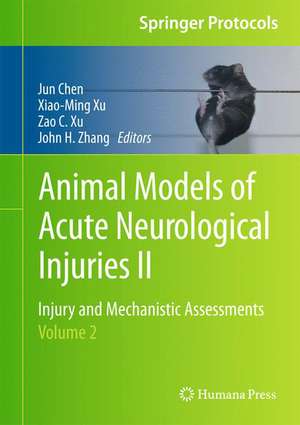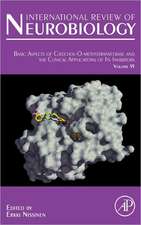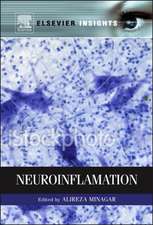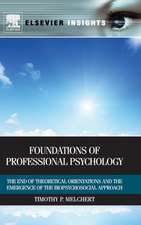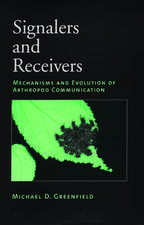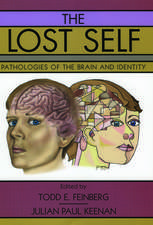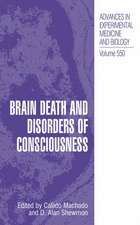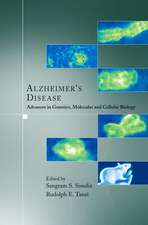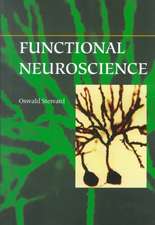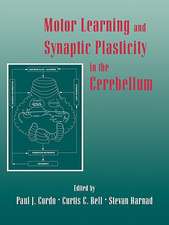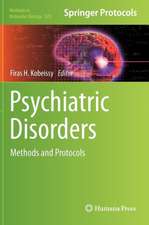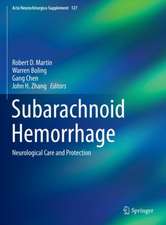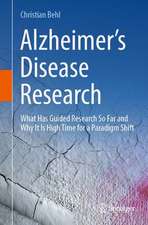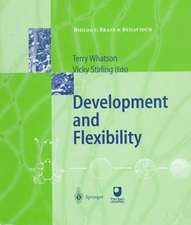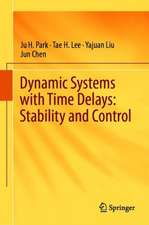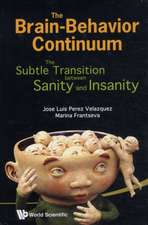Animal Models of Acute Neurological Injuries II: Injury and Mechanistic Assessments, Volume 2: Springer Protocols Handbooks
Editat de Jun Chen, Xiao-Ming Xu, Zao C. Xu, John H. Zhangen Limba Engleză Hardback – 11 apr 2012
Accessible and essential, Animal Models of Acute Neurological Injuries II: Injury and Mechanistic Assessments will be useful for trainees or beginners in their assessments of acute neurological injuries, for experienced scientists from other research fields who are interested in either switching fields or exploring new opportunities, and for established scientists within the field who wish to employ new assessments.
| Toate formatele și edițiile | Preț | Express |
|---|---|---|
| Paperback (2) | 727.07 lei 6-8 săpt. | |
| Humana Press Inc. – 23 aug 2016 | 727.07 lei 6-8 săpt. | |
| Humana Press Inc. – 23 aug 2016 | 727.43 lei 6-8 săpt. | |
| Hardback (2) | 982.09 lei 6-8 săpt. | |
| Humana Press Inc. – 18 mai 2012 | 982.09 lei 6-8 săpt. | |
| Humana Press Inc. – 11 apr 2012 | 984.44 lei 6-8 săpt. |
Din seria Springer Protocols Handbooks
- 18%
 Preț: 782.42 lei
Preț: 782.42 lei - 5%
 Preț: 1817.13 lei
Preț: 1817.13 lei - 18%
 Preț: 1120.18 lei
Preț: 1120.18 lei -
 Preț: 403.91 lei
Preț: 403.91 lei - 15%
 Preț: 662.30 lei
Preț: 662.30 lei - 18%
 Preț: 1855.11 lei
Preț: 1855.11 lei - 18%
 Preț: 1918.09 lei
Preț: 1918.09 lei - 18%
 Preț: 896.08 lei
Preț: 896.08 lei - 15%
 Preț: 644.82 lei
Preț: 644.82 lei - 20%
 Preț: 593.48 lei
Preț: 593.48 lei - 18%
 Preț: 966.27 lei
Preț: 966.27 lei - 5%
 Preț: 2329.29 lei
Preț: 2329.29 lei - 18%
 Preț: 952.09 lei
Preț: 952.09 lei - 5%
 Preț: 737.11 lei
Preț: 737.11 lei - 15%
 Preț: 648.24 lei
Preț: 648.24 lei - 18%
 Preț: 977.34 lei
Preț: 977.34 lei - 18%
 Preț: 1674.20 lei
Preț: 1674.20 lei - 18%
 Preț: 1841.06 lei
Preț: 1841.06 lei - 18%
 Preț: 970.87 lei
Preț: 970.87 lei - 18%
 Preț: 1588.19 lei
Preț: 1588.19 lei - 18%
 Preț: 1029.13 lei
Preț: 1029.13 lei - 5%
 Preț: 677.07 lei
Preț: 677.07 lei - 18%
 Preț: 1250.74 lei
Preț: 1250.74 lei - 5%
 Preț: 723.78 lei
Preț: 723.78 lei - 18%
 Preț: 900.18 lei
Preț: 900.18 lei - 18%
 Preț: 800.55 lei
Preț: 800.55 lei - 15%
 Preț: 645.60 lei
Preț: 645.60 lei - 5%
 Preț: 1487.03 lei
Preț: 1487.03 lei - 15%
 Preț: 645.47 lei
Preț: 645.47 lei
Preț: 984.44 lei
Preț vechi: 1200.54 lei
-18% Nou
Puncte Express: 1477
Preț estimativ în valută:
188.40€ • 195.96$ • 155.53£
188.40€ • 195.96$ • 155.53£
Carte tipărită la comandă
Livrare economică 14-28 aprilie
Preluare comenzi: 021 569.72.76
Specificații
ISBN-13: 9781617797811
ISBN-10: 1617797812
Pagini: 680
Ilustrații: XVIII, 718 p.
Dimensiuni: 178 x 254 x 43 mm
Greutate: 1.57 kg
Ediția:2012
Editura: Humana Press Inc.
Colecția Humana
Seria Springer Protocols Handbooks
Locul publicării:Totowa, NJ, United States
ISBN-10: 1617797812
Pagini: 680
Ilustrații: XVIII, 718 p.
Dimensiuni: 178 x 254 x 43 mm
Greutate: 1.57 kg
Ediția:2012
Editura: Humana Press Inc.
Colecția Humana
Seria Springer Protocols Handbooks
Locul publicării:Totowa, NJ, United States
Public țintă
Professional/practitionerCuprins
Introduction (Parts I-III).- Morphological Assessments of Global Cerebral Ischemia: Viable Cells.- Morphological Assessments of Global Cerebral Ischemia: Degenerated Cells.- Morphological Assessments of Global Cerebral Ischemia: Electron Microscopy.- Biochemical and Molecular Biological Assessments of Global Cerebral Ischemia: mRNA.- Biochemical and Molecular Biological Assessments of Global Cerebral Ischemia: Protein.- Neurobehavioral Assessments of Global Cerebral Ischemia.- Assessment of Neurogenesis in the Dentate Gyrus after Global or Focal Ischemia.- Infarct Measurement in Focal Cerebral Ischemia: TTC Staining.- Morphological Assessments of Focal Cerebral Ischemia: White Matter Injury.- Blood Flow Reduction: Laser Doppler, 14C-IAP.- Biochemical and Molecular Biological Assessments of Focal Cerebral Ischemia: mRNA and MicroRNA.- Biochemical and Molecular Biological Assessments of Focal Cerebral Ischemia: Protein.- Assessments of Inflammation After Focal Cerebral Ischemia.- Neurobehavioral Assessments of Focal Cerebral Ischemia: Sensorimotor Deficit.- Neurobehavioral Assessments of Focal Cerebral Ischemia: Cognitive Deficit.- Assessment of Neurogenesis in Models of Focal Cerebral Ischemia.- Assessment of Angiogenesis in Models of Focal Cerebral Ischemia.- Morphological Assessments of Neonatal Hypoxia-Ischemia: In Situ Cell Degeneration.- Morphological Assessments of Neonatal Hypoxia-Ischemia: White Matter Injury.- Biochemical and Molecular Biological Assessments of Neonatal Hypoxia-Ischemia: Cell Signaling.- Biochemical and Molecular Biological Assessments of Neonatal Hypoxia-Ischemia: Inflammation.- Neurobehavioral Assessments of Neonatal Hypoxia-Ischemia.- Assessment of Neurogenesis and White Matter Regeneration.- Assessments for Traumatic Brain Injury: An Introduction.- Morphological Assessments of Traumatic Brain Injury.- Assessment of Cerebral Vascular Dysfunction after Traumatic Brain Injury.- Assessment of Membrane Permeability After Traumatic Brain Injury.- Assessment of Neurogenesis by BrdU Labeling After Traumatic Brain Injury.- Electrophysiological Approaches in Traumatic Brain Injury.- Biochemical and Molecular Biological Assessments of Traumatic Brain Injury.- Assessments of Oxidative Damage and Lipid Peroxidation after Traumatic Brain Injury and Spinal Cord Injury.- Neurobehavioral Assessments of Traumatic Brain Injury.- Vestibular Assessments Following Traumatic Brain Injury.- Introduction on Assessments for Spinal Cord Injury.- Morphological Assessments Following Spinal Cord Injury.- Assessment of Lesion and Tissue Sparing Volumes Following Spinal Cord Injury.- Retrograde Axonal Tract Tracing.- Anterograde Axonal Tract Tracing.- Assessments of Gliogenesis After Spinal Cord Injury.- Assessing Microvessels After Spinal Cord Injury.- Physiological Assessment of Spinal Cord Injury.- Electrophysiological Assessment of Spinal Cord Function on Rodents Using tcMMEP and SSEP.- Operant Conditioning of Spinal Cord Reflexesin Rats.- Cellular and Molecular Biological Assessments of Inflammation and Autoimmunity After Spinal Cord Injury.- Neurobehavioral Assessments of Spinal Cord Injury.- Basso, Beattie, and Bresnahan (BBB) Scale Locomotor Assessment Following Spinal Cord Injury and Its Utility as a Criterion for Other Assessments.- High Speed Video Recording Used for the Analysis of Hand Shaping in Over Ground Walking, Cylinder Exploration, Skilled Reaching, and Rung Walking in Rats.- Automated Gait Analysis Following Spinal Cord Injury.- Forelimb Functional Assessments of Rats and Mice After Cervical Spinal Cord Injury.- Swimming as an Assessment of Hindlimb Function in Animals with Traumatic Spinal Cord Injury.- Neuroimaging Assessment of Spinal Cord Injury in Rodents.
Recenzii
“This an atlas-text ‘protocols’ step by stepexplanation of animal cerebral ischemia, brain trauma, & spinal cordinjury. … I recommend this book for ischemia and trauma students and physiologystudents.” (Joseph J. Grenier, Amazon.com, October, 2015)
Textul de pe ultima copertă
The successful previous volume on this topic provided a detailed benchwork manual for the most commonly used animal models of acute neurological injuries including cerebral ischemia, hemorrhage, vasospasm, and traumatic brain and spinal cord injuries. Animal Models of Acute Neurological Injuries II: Injury and Mechanistic Assessments aims to collect chapters on assessing these disorders from cells and molecules to behavior and imaging. These comprehensive assessments are the key for understanding disease mechanisms as well as developing novel therapeutic strategies to ameliorate or even prevent damages to the nervous system. Volume 2 examines global cerebral ischemia, focal cerebral ischemia, and neonatal hypoxia-ischemia, as well as intensive sections covering traumatic brain injury and spinal cord injury. Designed to provide both expert guidance and step-by-step procedures, chapters serve to increase understanding in what, why, when, where, and how a particular assessment is used.
Accessible and essential, Animal Models of Acute Neurological Injuries II: Injury and Mechanistic Assessments will be useful for trainees or beginners in their assessments of acute neurological injuries, for experienced scientists from other research fields who are interested in either switching fields or exploring new opportunities, and for established scientists within the field who wish to employ new assessments.
Accessible and essential, Animal Models of Acute Neurological Injuries II: Injury and Mechanistic Assessments will be useful for trainees or beginners in their assessments of acute neurological injuries, for experienced scientists from other research fields who are interested in either switching fields or exploring new opportunities, and for established scientists within the field who wish to employ new assessments.
Caracteristici
Presents the material in a disease/disorder oriented manner for convenient reference Offers both recommended, established techniques and alternative methods that have their own special utility Features key tips and implementation advice to ensure successful results Includes supplementary material: sn.pub/extras
